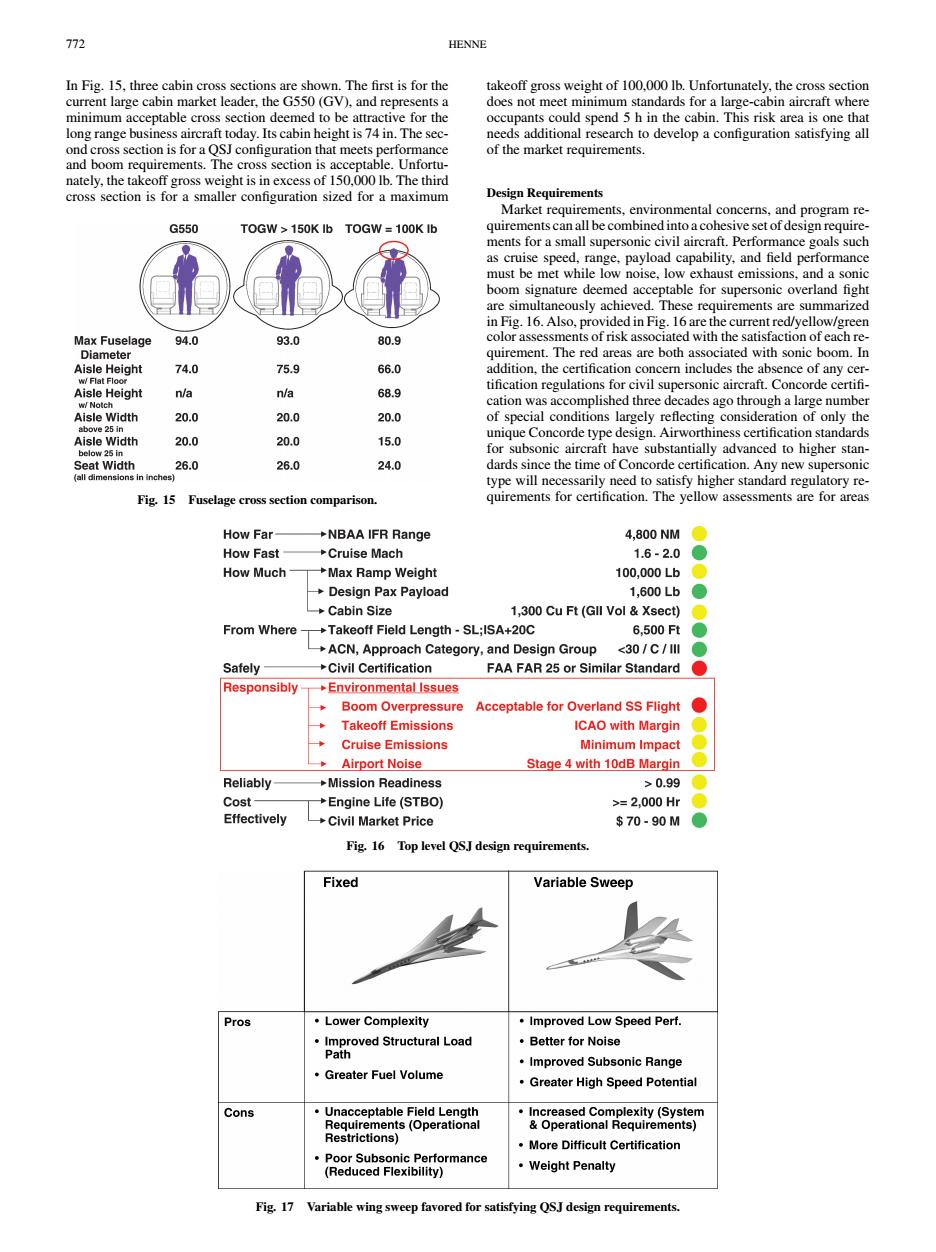正在加载图片...

772 HENNE In Fig.15,three cabin cross sections are shown.The first is for the takeoff gross weight of 100,000 lb.Unfortunately,the cross section current large cabin market leader,the G550(GV).and represents a does not meet minimum standards for a large-cabin aircraft where minimum acceptable cross section deemed to be attractive for the occupants could spend 5 h in the cabin.This risk area is one that long range business aircraft today.Its cabin height is 74 in.The sec- needs additional research to develop a configuration satisfying all ond cross section is for a QSJ configuration that meets performance of the market requirements. and boom requirements.The cross section is acceptable.Unfortu- nately,the takeoff gross weight is in excess of 150,000 Ib.The third cross section is for a smaller configuration sized for a maximum Design Requirements Market requirements,environmental concerns,and program re- G550 TOGW>150K Ib TOGW=100K Ib quirements can all be combined into a cohesive set of design require- ments for a small supersonic civil aircraft.Performance goals such as cruise speed,range,payload capability,and field performance must be met while low noise,low exhaust emissions.and a sonic boom signature deemed acceptable for supersonic overland fight are simultaneously achieved.These requirements are summarized in Fig.16.Also,provided in Fig.16 are the current red/yellow/green Max Fuselage 94.0 93.0 80.9 color assessments of risk associated with the satisfaction of each re- Diameter quirement.The red areas are both associated with sonic boom.In Aisle Height 74.0 75.9 66.0 addition,the certification concern includes the absence of any cer- w/Flat Floor Aisle Height tification regulations for civil supersonic aircraft.Concorde certifi- n/a n/a 68.9 w/Notch cation was accomplished three decades ago through a large number Aisle Width 20.0 20.0 20.0 of special conditions largely reflecting consideration of only the above 25 in Aisle Width 20.0 20.0 15.0 unique Concorde type design.Airworthiness certification standards below 25 in for subsonic aircraft have substantially advanced to higher stan- Seat Width 26.0 26.0 24.0 dards since the time of Concorde certification.Any new supersonic (all dim ensions in inches) type will necessarily need to satisfy higher standard regulatory re- Fig.15 Fuselage cross section comparison. quirements for certification.The yellow assessments are for areas How Far NBAA IFR Range 4,800NM How Fast- Cruise Mach 1.6-2.0 How Much Max Ramp Weight 100,000Lb ● Design Pax Payload 1,600Lb Cabin Size 1,300 Cu Ft(GlI Vol Xsect) From Where- Takeoff Field Length-SL;ISA+20C 6,500Ft ACN,Approach Category,and Design Group <30/C/Il Safely Civil Certification FAA FAR 25 or Similar Standard Responsibly Environmental Issues Boom Overpressure Acceptable for Overland SS Flight Takeoff Emissions ICAO with Margin Cruise Emissions Minimum Impact Airport Noise Stage 4 with 10dB Margin Reliably Mission Readiness >0.99 Cost Engine Life(STBO) >=2,000Hr Effectively Civil Market Price $70-90M Fig.16 Top level QSJ design requirements Fixed Variable Sweep Pros ·Lower Complexity Improved Low Speed Perf. Improved Structural Load Better for Noise Path Improved Subsonic Range ·Greater Fuel Volume Greater High Speed Potential Cons Unacceptable Field Length Increased Complexity (System Requirements(Operational Operational Requirements) Restrictions) More Difficult Certification Poor Subsonic Performance (Reduced Flexibility) ·Weight Penalty Fig.17 Variable wing sweep favored for satisfying QSJ design requirements.772 HENNE In Fig. 15, three cabin cross sections are shown. The first is for the current large cabin market leader, the G550 (GV), and represents a minimum acceptable cross section deemed to be attractive for the long range business aircraft today. Its cabin height is 74 in. The second cross section is for a QSJ configuration that meets performance and boom requirements. The cross section is acceptable. Unfortunately, the takeoff gross weight is in excess of 150,000 lb. The third cross section is for a smaller configuration sized for a maximum Fig. 15 Fuselage cross section comparison. Fig. 16 Top level QSJ design requirements. Fig. 17 Variable wing sweep favored for satisfying QSJ design requirements. takeoff gross weight of 100,000 lb. Unfortunately, the cross section does not meet minimum standards for a large-cabin aircraft where occupants could spend 5 h in the cabin. This risk area is one that needs additional research to develop a configuration satisfying all of the market requirements. Design Requirements Market requirements, environmental concerns, and program requirements can all be combined into a cohesive set of design requirements for a small supersonic civil aircraft. Performance goals such as cruise speed, range, payload capability, and field performance must be met while low noise, low exhaust emissions, and a sonic boom signature deemed acceptable for supersonic overland fight are simultaneously achieved. These requirements are summarized in Fig. 16. Also, provided in Fig. 16 are the current red/yellow/green color assessments of risk associated with the satisfaction of each requirement. The red areas are both associated with sonic boom. In addition, the certification concern includes the absence of any certification regulations for civil supersonic aircraft. Concorde certifi- cation was accomplished three decades ago through a large number of special conditions largely reflecting consideration of only the unique Concorde type design. Airworthiness certification standards for subsonic aircraft have substantially advanced to higher standards since the time of Concorde certification. Any new supersonic type will necessarily need to satisfy higher standard regulatory requirements for certification. The yellow assessments are for areas